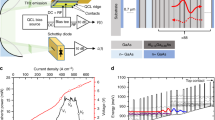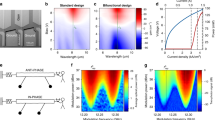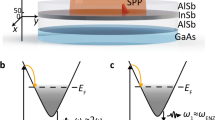Abstract
Spontaneous emission is not inherent to an emitter, but rather depends on its electromagnetic environment. In a microcavity, the spontaneous emission rate can be greatly enhanced compared with that in free space. This so-called Purcell effect can dramatically increase laser modulation speeds, although to date no time-domain measurements have demonstrated this. Here we show extremely fast photonic crystal nanocavity lasers with response times as short as a few picoseconds resulting from 75-fold spontaneous emission rate enhancement in the cavity. We demonstrate direct modulation speeds far exceeding 100 GHz (limited by the detector response time), already more than an order of magnitude above the fastest semiconductor lasers. Such ultrafast, efficient, and compact lasers show great promise for applications in high-speed communications, information processing, and on-chip optical interconnects.
This is a preview of subscription content, access via your institution
Access options
Subscribe to this journal
Receive 12 print issues and online access
$209.00 per year
only $17.42 per issue
Buy this article
- Purchase on Springer Link
- Instant access to full article PDF
Prices may be subject to local taxes which are calculated during checkout





Similar content being viewed by others
References
Purcell, E. Spontaneous emission probabilities at radio frequencies. Phys. Rev. 69, 681 (1946).
Yablonovitch, E. Inhibited spontaneous emission in solid-state physics and electronics. Phys. Rev. Lett. 58, 2059–2062 (1987).
John, S. Strong localization of photons in certain disordered dielectric superlattices. Phys. Rev. Lett. 58, 2486–2489 (1987).
Englund, D. et al. Controlling the spontaneous emission rate of single quantum dots in a 2D photonic crystal. Phys. Rev. Lett. 95, 013904 (2005).
Badolato, A. et al. Deterministic coupling of single quantum dots to single nanocavity modes. Science 308, 1158–1161 (2005).
Yoshie, T. et al. Vacuum Rabi splitting with a single quantum dot in a photonic crystal nanocavity. Nature 432, 200–203 (2004).
Khitrova, G., Gibbs, H. M., Kira, M., Koch, S. W. & Scherer, A. Vacuum Rabi splitting in semiconductors. Nature Phys. 2, 81–90 (2006).
Goldstein, E. & Meystre, P. in Spontaneous Emission and Laser Oscillations in Microcavities (eds Yokoyama, H. & Ujihara, K.) 1–46 (CRC, New York, 1995).
Lodahl, P. et al. Controlling the dynamics of spontaneous emission from quantum dots by photonic crystals. Nature 430, 654–657 (2004).
Happ, T. D. et al. Enhanced light emission of In×Ga12×As quantum dots in a two-dimensional photonic-crystal defect microcavity. Phys. Rev. B 66, 041303 (2002).
Gibbs, H. M. in Optics of Semiconductors and Their Nanostructures (eds Kalt, H. & Hetterich, M.) 189–208 (Springer, Berlin, 2004).
Cheng, W. H. et al. Efficient single-photon sources based on low-density quantum dots in photonic-crystal nanocavities. Phys. Rev. Lett. 96, 117401 (2006).
Painter, O. et al. Two-dimensional photonic band-gap defect mode laser. Science 284, 1819–1821 (1999).
Loncar, M., Yoshie, T., Scherer, A., Gogna, P. & Qiu, Y. Low-threshold photonic crystal laser. Appl. Phys. Lett. 81, 2680–2682 (2002).
Park, H. G. et al. Electrically driven single-cell photonic crystal laser. Science 305, 1444–1447 (2004).
Baba, T. et al. Observation of fast spontaneous emission decay in GaInAsP photonic crystal point defect nanocavity at room temperature. Appl. Phys. Lett. 85, 3889–3891 (2004).
Yoshie, T., Loncar, M. & Scherer, A. High frequency oscillation in photonic crystal naolasers. Appl. Phys. Lett. 84, 3543–3545 (2004).
Deng, H. et al. Transverse and temporal mode dependence on mirror contrast in microcavity lasers. J. Quantum Electron. 31, 2026–2036 (1995).
Deng, H., Deng, Q. & Deppe, D. G. Very small oxide-confined vertical-cavity surface-emitting lasers with a bulk active region. Appl. Phys. Lett. 70, 741–743 (1997).
Coldren, L. A. & Corzine, S. W. Diode Lasers and Photonic Integrated Circuits (Wiley, New York, 1995).
Chang, C., Chrostowski, L. & Chang-Hasnain, C. J. Injection-locking of vertical cavity surface emitting lasers: Theory and experiments. J. Sel. Top. Quantum Electron. 9, 1386–1392 (2003).
Lear, K. L. et al. Small and large signal modulation of 850 nm oxide-confined vertical-cavity surface-emitting lasers. Advances in Vertical Cavity Surface Emitting Lasers in Trends in Optics and Photonics Series 15, 69–74 (1997).
Yamamoto, Y., Machida, S. & Bjork, G. Microcavity semiconductor laser with enchanced spontaneous emission. Phys. Rev. A 44, 657–668 (1991).
Song, B., Noda, S., Asano, T. & Akahane, Y. Ultra-high Q photonic double-heterostructure nanocavity. Nature Mater. 4, 2007–2010 (2005).
Altug, H. & Vuckovic, J. Two-dimensional coupled photonic crystal resonator arrays. Appl. Phys. Lett. 84, 161–163 (2004).
Altug, H. & Vuckovic, J. Photonic crystal nanocavity array laser. Opt. Express 13, 8820–8828 (2005).
Schmidt, R. et al. Fabrication of genuine single-quantum-dot light-emitting diodes. Appl. Phys. Lett. 88, 121115 (2006).
Acknowledgements
This work has been supported by the MARCO IFC Center, NSF Grant Nos ECS-0424080 and ECS-0421483, the MURI Center for Photonic Quantum Information Systems (ARO/DTO Program No. DAAD19-03-1-0199), as well as Intel (H.A.) and NDSEG (D.E.) Fellowships.
Author information
Authors and Affiliations
Corresponding author
Ethics declarations
Competing interests
The authors declare no competing financial interests.
Rights and permissions
About this article
Cite this article
Altug, H., Englund, D. & Vučković, J. Ultrafast photonic crystal nanocavity laser. Nature Phys 2, 484–488 (2006). https://doi.org/10.1038/nphys343
Received:
Revised:
Accepted:
Published:
Issue Date:
DOI: https://doi.org/10.1038/nphys343
This article is cited by
-
Electrically tunable optical properties of one-dimensional photonic crystal containing nanocomposite structurally chiral material
Indian Journal of Physics (2024)
-
Photonic crystals umbrella for thermal desalination: simulation study
Scientific Reports (2022)
-
Room-temperature upconverted superfluorescence
Nature Photonics (2022)
-
Design of Multiple Resonant Reflectance Filter Using One-Dimensional Fibonacci Superconductor Photonic Crystal
Journal of Superconductivity and Novel Magnetism (2022)
-
Spontaneous emission in micro- or nanophotonic structures
PhotoniX (2021)



